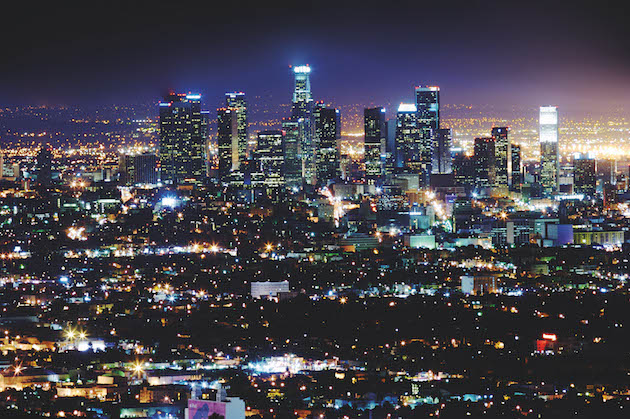Lighting companies are offering sophisticated systems that control outputs across large urban spaces. Could it transform the way we experience cities?
 Los Angeles Street Lighting. Image courtesy Signify
Los Angeles Street Lighting. Image courtesy Signify
Words by Lemma Shehadi
Growing urban centres consume two-thirds of the world’s energy. ‘And a fair share of that is consumed by lighting,’ says Pierre-Yves Panis, head of design at Signify, the company formerly known as Philips Lighting.
Lighting technology is one of the main players in the transition to data-driven ‘smart cities’, with Miami, Paris and Jakarta having recently rolled out large-scale outdoor lighting systems managed by software that connects all light outputs to a central system. ‘We’re devising the right ecosystems for lighting projects, rather than an individual light source,’ says Panis. One example is the Optus multi-purpose sports stadium in Perth, Australia. At this recently completed Signify project, 22,000 LEDs, all connected through a central management system, illuminate the pitch, seating area, offices and shops, as well as delivering light shows.
Traditional lighting companies, such as Signify, Osram and General Electric, have shifted their focus from making light bulbs and related products, to providing systems and services. The declining costs and improved performance of LEDs have led the market to mature, and emerging technologies mean new opportunities for the lighting industry. Signify’s sales in systems and services grew by 51 per cent in 2017, according to its annual report.
Read more: Can we outsmart the smart city?
The rebrand of the company name in May this year signals this shift. This was the first name change since the world’s largest lighting company was set up in Eindhoven in 1891. Royal Philips, the technology company that owned Philips Lighting, spun the company off in 2016. ‘Light has become an intelligent language, which connects and conveys meaning,’ read the rebrand announcement – a claim that may have been met with rolling eyes.
Alongside this, Signify launched Interact, a cloud-based Internet of Things (IoT) platform that supplies lighting management software for public spaces, as well as homes and business. Osram and GE have also recently launched their own IoT platforms.
Efficiency, the environment and the Internet of Things
The transition towards IoT lighting responds to a need to optimise energy consumption across the built environment. IoT technologies make it possible to control when and how light is used from remote locations. ‘We want to simplify light usage, to produce the right light at the right moment,’ says Panis. In Cardiff, for example, an Interact project managing 14,000 outdoor luminaires resulted in 60 per cent annual energy savings.
In addition, occupancy sensors in the light fixtures collect insights into how a space is used, which helps to optimise energy consumption. ‘As designers, we’re using this connectivity to create light that is more specific to context,’ says Panis. These design considerations cater towards changing lifestyles, as studies show that city dwellers spend most of their time indoors.
Lights fitted with occupancy sensors can also benefit other emerging smart technologies. For example, the management systems can be combined with other applications to monitor environmental noise, traffic flows and pollution. Or luminaires can be fitted with Li-Fi, a new technology that derives internet connectivity from light. These technologies not only present business opportunities for lighting companies, they give local municipalities better control over a city’s daily problems.
Despite these advantages, the complexity of IoT systems is such that they require a range of partners to implement them. ‘We work with city officials, planners, tech providers or builders, among others,’ says Panis. ‘Everybody has different solutions based on their expertise and we have to satisfy everyone.’He cites a recent lighting systems project on a street in Eindhoven, renowned as the Netherlands’ longest street of bars. ‘In collaboration with the local police, we experimented with lighting solutions that could help pacify the street at night,’ he explains. ‘But the lighting experience had to remain agreeable to bar-goers. We were balancing the needs of both sides.’
This highly interdependent approach presents one of the major challenges to IoT projects. Research by technology giant Cisco published in May 2017 showed that 60 per cent of IoT initiatives stalled at the proof of concept stage and that only 26 per cent of companies considered their projects a success. ‘I cannot name an instance where we haven’t come to a mutually beneficial solution,’ insists Panis, ‘but for the IoT initiative to work, the solutions can’t be technology-driven. Other factors must be considered.’
The security question
In addition, data-driven services have raised concerns about security and privacy across IoT sectors. The wide range of providers in an IoT project weakens control over the data that is collected and used. It has also made systems vulnerable to cyber attack. For a city such as Miami, where 500,000 outdoor lights are connected to once central management system, the wide-reaching impact of a potential attack is clear. ‘Signify works extensively with security researchers and ethical hackers,’ says a spokesperson, ‘For some of our products and systems we collect data, but this is collected anonymously.’ This security will also depend on the level of support and software updates that commercially driven IoT companies are willing to provide to their customers in the long term, after a sale has been made.
Despite these challenges, Panis remains optimistic about IoT lighting’s potential to shape energy-efficient smart cities. ‘Urban centres of the future should be centred on the living experience of the city-dweller. We should work towards better mobility, less traffic, better access to work and better living spaces. IoT solutions will help us get there,’ he says.
How would he light these cities of the future, I ask him. ‘I imagine a personalised light signature that follows you around the city. It changes according to the time of day and on your activity,’ he speculates. ‘You could team the light with your friends to create a micro-environment. It would be tailored to your needs and daily rhythm.’















